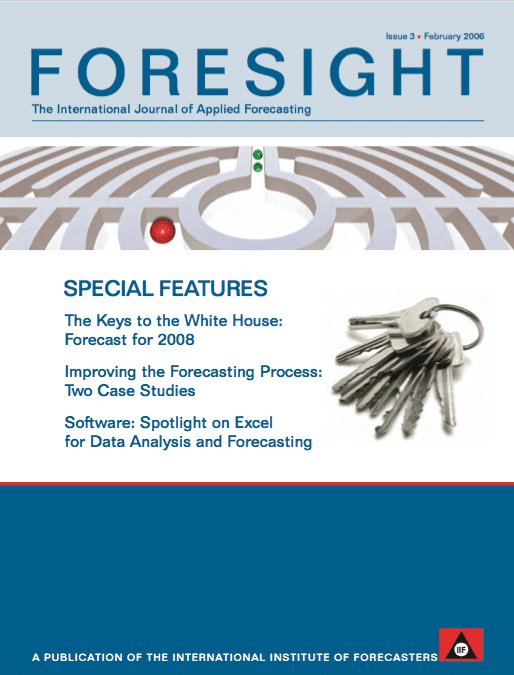FORESIGHT, Issue 3
$45.00
Description
Winter 2006 Issue
Special Feature: Software: Spotlight on Excel for Data Analysis and Forecasting
- Introduction by Editor, Len Tashman
According to major surveys of organizational forecasting practices, there is continued widespread use of spreadsheets for forecasting, despite major advances during the last 20 years in the availability, performance, and ease of use of business-forecasting software. In this software section, we examine the reliability and capability of Microsoft Excel as a statistical tool. - Incorrect Nonlinear Trend Curves in Excel by Rick Hesse
Many software programs, including Excel, make it easy to fit exponential trends (that is compound interest growth) to time series data. However, with Excel and some other products, there is a big problem: the exponential functions are done incorrectly because they use logarithmic transformations. Rick illustrates the right way to fit exponential trends, and he shows how misleading the Excel procedure can be. - The Unreliablity of Excel’s Statistical Procedures by Bruce D. McCullough
Documents serious flaws in Excel’s statistical algorithms, and he advises that Excel should not substitute for a commercial statistical program. Bruce has done extensive testing of statistical algorithms in both professional statistical packages and in Excel. He reports that many Excel algorithms are faulty and that Microsoft’s attempts to correct these errors have been far from successful. - On The Use and Abuse of Microsoft Excel by Paul Fields
While Excel has serious inadequacies as a statistical modeling tool, you do not need to throw it out. An analyst can still make safe and effective use of Excel—the keys are to learn what Excel can and cannot do, to master the skills to use it, and to install add-ins to enhance its capabilities.
Special Feature: The Keys to the Whitehouse: Forecast for 2008
- The Keys to the Whitehouse: Forecast for 2008 by Allan J. Lichtman
The Keys to the White House is a historically based prediction system that retrospectively accounts for the popular-vote winners of every American presidential election from 1860 to 1980. The system has forecasted the popular-vote winners of every presidential election from 1984 through 2004. It proves that presidential election results turn primarily on the performance of the party controlling the White House and that politics as usual by the challenging candidate has no impact on results. The system includes no polling data, and it considers performance indicators that transcend economic concerns. Already the Keys are lining up for 2008, demonstrating surprisingly bright prospects for Democrats to recapture the White House. - Index Methods for Forecasting: an Application to the American Presidential Elections by J. Scott Armstrong, Alfred G. Kuzan
The authors describe Allan Lichtman’s Keys Model as an example of an index method of forecasting, which assigns ratings of favorable, unfavorable, or indeterminate to influencing variables. They describe how index methods have been applied in other decision-making contexts, and they discuss when such methods might be useful analytical tools for business forecasters. In the context of presidential election forecasting, they compare the Keys model to several regression models and find that the Keys model stacks up quite well against these more sophisticated alternatives.
Articles
-
- Book Review by Roy Batchelor
Dow 36,000: The New Strategy for Profiting from the Coming Rise in the Stock Market, by James Glassman and Kevin Hassett - Increasing the Credibility of Your Forecasts: 7 Suggestions by Roy Pearson
Credible: capable of being believed and worthy of confidence. Credibility is essential for the acceptance of your forecasts. Roy Pearson offers solid advice on enhancing the credibility of forecasts and on reducing forecasting errors. His suggestions are based on years of experience, surveys of academics, and knowledge of best practices. - Credit Scoring: The State of the Art by Lyn C. Thomas
Credit scoring is the most successful and widely used application of forecasting in the whole financial sector. The name refers to the techniques that help lenders decide whether or not to approve loan applications. In this article, Lyn Thomas discusses the origins of credit scoring, describes the major techniques in use, and examines the recent advances in the field designed to deal with new regulations and a more competitive consumer credit market.
- Book Review by Roy Batchelor







